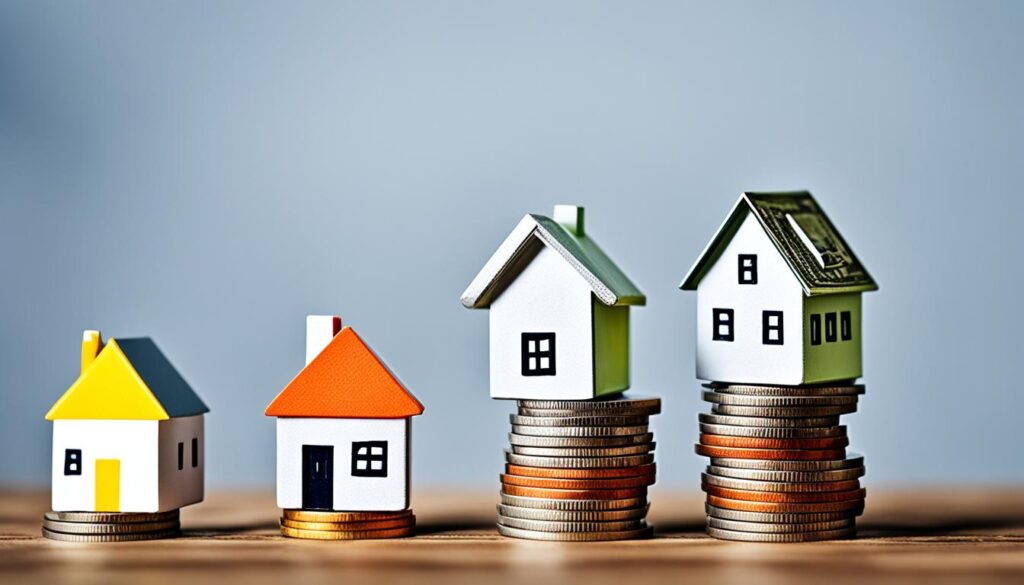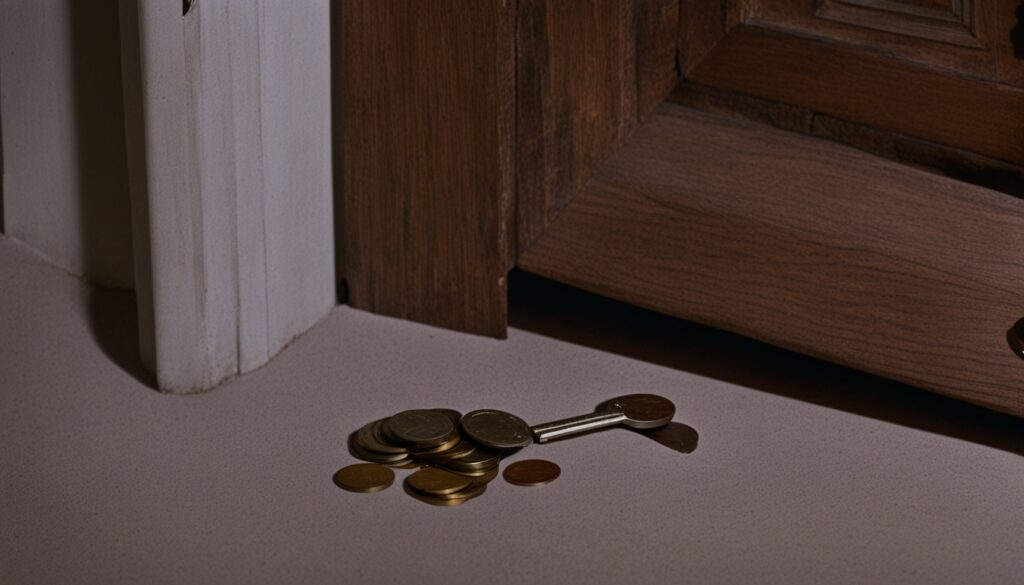Investing in real estate can help you make money without much effort. It can also make your investment mix stronger. Many think you need a lot of cash to start, but that’s not true. There are ways to get into real estate with little or no money down. We’ll look at some strategies and options for this quite closely.
Key Takeaways:
- Investing in real estate can be done with little to no money using various strategies.
- Explore financing options such as government-backed loans and seller financing.
- Consider house hacking and partnerships to generate rental income and share costs.
- Utilize creative financing options like seller financing, hard money loans, and microloans.
- Assumption of mortgage and lease options can be viable no-money-down strategies.
Financing Options for Real Estate Investment
Investing in real estate can be tough because of the need for a big down payment. Normally, you’ll have to pay 15% to 25% of the place’s price upfront for a loan. But, there are many ways to finance your investment without this high initial cost.
One smart choice is a government-backed loan. Loans like those from the FHA and VA can ask for a smaller down payment than regular loans. They are insured by the government and are often easier to get for those without a big pile of money saved.
Seller financing is another path. This involves buying the property straight from the owner. They become your lender instead of a bank. It can work better if the seller likes you or needs to sell fast.
Using your home’s equity could also open doors. If you already own a home, you might tap into its value through a HELOC or a cash-out refinance. This lets you use the money from your home to buy another property. It’s a way to capitalize on the growth of your home’s worth.
Financing Options for Real Estate Investment – Summary
| Financing Option | Key Features |
|---|---|
| Government-Backed Loans (FHA, VA) | – Lower down payment requirements – Backed by the government |
| Seller Financing | – Opportunity for negotiation – Potential for more flexible terms |
| Home Equity (HELOC, Cash-Out Refinancing) | – Access to existing home equity – Utilize appreciation in property value |
By looking at these choices, investing in real estate can become easier. Evaluating each option is crucial. Think about interest rates, how fast you can pay back, and risks. This helps you pick what’s best for your investment goals.

House Hacking and Partnerships
House hacking is a clever way to start in real estate with low costs up front. You buy a multi-unit property, live in one unit, and rent the others. This renting out covers your mortgage and can even bring in extra money. It’s a way to use your property to grow your equity and income.
This method lets you step into investing with little or no money. Instead of paying rent, you use the rental money from other units to pay for your housing. This removes a big hurdle for many who want to invest.
House hacking also cuts your monthly expenses and boosts what you save. The rent from the other units can mean living for free or slashing your housing costs. The saved money can go towards more investments, moving you towards financial freedom quicker.
For those short on down payment funds, partnering up is an option. By teaming up with someone who has the money, you can buy a property together. This makes bigger investments possible than what you can do alone.
Partnerships come in different shapes, from joint ventures to forming an LLC. It’s crucial to set clear roles, who does what, and how profits are shared. Trust, open discussions, and having the same money goals are vital for a good partnership.
Choosing house hacking or partnerships both lead to real estate investing without a big start. The important thing is to think through your options, look at your cash, and make a strong investing plan. Real estate investing is for the long haul. Making smart choices is the key to wealth from property over time.
Advantages of House Hacking:
- Generate rental income to cover mortgage payments
- Create additional cash flow
- Build equity through property ownership
- Lower monthly expenses and increase savings
- Access larger investment opportunities through partnerships
Considerations for Partnerships:
- Identify partners with complementary skills and resources
- Establish clear roles and responsibilities
- Define profit-sharing agreements upfront
- Maintain open communication and trust
- Align financial goals and long-term vision

Creative Financing Options
Investing in real estate with little to no money down is possible with creative financing. You can avoid the big initial costs of traditional methods. This lets you get started in real estate without a large upfront payment. Here are some top creative financing options:
Seller Financing
Seller financing means the seller helps finance your purchase. They become the lender, making the process smoother. You agree on a payment plan over time. It’s a win-win, allowing buyers to get in with fewer costs and sellers to sell quicker.
Hard Money Loans
Hard money loans are a quick capital solution. They’re short-term loans with the property as a security. They might have high-interest rates but are fast to secure. This quick access to funds eases the burden of a large down payment.
Credit Cards and Microloans
Credit cards and microloans can also be options. Beware, they come with risks. Credit cards with good terms can fund your initial investments. Microloans, usually from nonprofits or online platforms, are also available. But, remember the high interest and unfavorable terms that might come with them.
Using these creative financing options, you can start your real estate journey without huge upfront costs. Remember to carefully weigh the pros and cons of each before deciding.

| Financing Option | Description |
|---|---|
| Seller Financing | The seller acts as the lender, enabling you to purchase the property with little to no money down. |
| Hard Money Loans | Short-term loans provided by private individuals or groups, secured by the property itself. |
| Credit Cards and Microloans | Potential sources of initial investment funds, but must be approached with caution due to high interest rates and unfavorable terms. |
Assumption of Mortgage and Lease Options
Investing in real estate with no money down has its tricks, like assuming a mortgage or using lease options. These methods let investors jump into real estate without big upfront costs.
Assumption of Mortgage
Assuming a mortgage means you take over the seller’s mortgage payments. It’s good for investors wanting a property but not a big down payment. Through this, investors use the existing loan and don’t need their own.
This method shines when the mortgage terms are good, like low interest. It helps investors get into a property without lining up their own loan first or spending much upfront.

Lease Options
Lease options are nice for those looking to own a property someday without upfront costs. Here, the investor rents the property they aim to buy later.
The property owner usually asks for higher rent, with some going towards the buying price. It lets investors increase their stake in the property over the lease. In the end, they can decide to buy it.
This option means investors can earn rent and work towards owning the property eventually. It’s perfect for those not ready for a big down payment but still keen on real estate.
Mortgage assumption and lease options let you invest in real estate with little or no money down. They use existing loans or let you slowly gain ownership. But remember, like any investment, check the risks and rewards first.
Government Programs and Grants
Real estate offers big financial rewards, but it needs a lot of money up front. Luckily, there are government programs and grants to help. They make it easier to start in real estate, even if you don’t have much money.
The U.S. Department of Agriculture’s Rural Development office has a great program. It offers mortgages with no down payment for houses in rural areas. If you dream of owning land in the countryside, this is a perfect chance.
The Small Business Administration (SBA) also helps, offering loans for commercial real estate. You don’t need a big down payment. This support is good for both business owners and investors.
With these government aids, challenges in starting with real estate are easier. They help you start building wealth and reaching your money goals.
Benefits of Government Programs and Grants
- Reduced down payment requirements
- Access to favorable interest rates
- Opportunity to invest in rural properties
- Support for commercial real estate ventures
Government programs and grants make investing in real estate more affordable. They lower down payments and open funding doors.
Considerations for Government Programs and Grants
Before you dive into these programs, there are important things to think about:
- You must meet certain conditions to apply. Be sure to check them.
- Some programs have rules like where you must live or what you can do with the property. Know these rules to match your goals.
- The application process can be detailed. Prepare all needed documents and submit a strong application to increase your chances.
Table: Government Programs and Grants Comparison
| Program | Benefits | Eligibility |
|———————————-|————————————–|————————————————|
| USDA Rural Development Mortgages | Low or 0% down payment | Properties in designated rural areas |
| Small Business Administration | Lower down payment requirements | Commercial real estate investments |
With these programs and grants, you can get a head start in real estate. They lower the financial hurdle and welcome you to the real estate world.
Using Private Money and Gap Lenders
For real estate projects, private money lenders and gap lenders are different funding choices. Private lenders give loans for real estate but at a higher rate. They help those who need money fast or can’t get regular bank loans.
Gap lenders are also special. They help with the down payment in return for some of the property. This way, investors can buy real estate with less money at the start.
But, using these lenders can have extra costs. For example, you might pay more in interest or have to share ownership. Check the details to make sure it fits your financial plans.
Let’s look at a story to understand this more:
John wants to invest in real estate but doesn’t have the full down payment. A private money lender steps in and offers a loan at a higher interest. With this help, John buys the property and starts his investment.
Now, let’s see how these lenders help:
| Financing Option | Interest Rate | Down Payment | Ownership Stake |
|---|---|---|---|
| Private Money Lender | 8% | N/A | N/A |
| Gap Lender | N/A | Covered | 10% |
Private lenders charge 8% interest. Gap lenders pay for the down payment but take a 10% share in the property. This can be good for investors with little cash.
Whether to use private or gap lenders is up to the investor. Think about the costs and benefits. You can use these lenders to help reach your investment dreams.
Using the BRRRR Method
The BRRRR method stands for buy, renovate, rent, refinance, and repeat. It’s a smart way for real estate investors to start without much money. This method allows investors to reuse their starting funds and use a property’s growth in value.
Here’s a simple breakdown of the BRRRR method:
- Buy: Investors look for properties that may increase in value. They buy these using various funding like private loans or seller’s help.
- Renovate: After buying, investors work on the property to make it worth more. They might fix it up, change its look, or add more units to earn more in rent.
- Rent: Once the property looks its best, it’s time to find tenants. Charging the right rent helps keep money coming in regularly.
- Refinance: With rent coming in, investors can refinance the property. They get a new loan based on the property’s current value. This way, they can get back most, if not all, of their initial cash.
- Repeat: After refinancing, they use that money to buy the next property. Then, they start the process over with the new property. This strategy lets investors grow their property collection step by step.
The BRRRR strategy has many benefits for those who want to invest in real estate. It helps with starting without much cash. Plus, it’s a way to make money by either the properties going up in value or by the rent they earn.
Example Case Study: BRRRR Method in Action
Let’s say Sarah is an investor using the BRRRR method. She buys a property for $100,000 with the help of a private loan. Spending $20,000 on renovations makes the property nicer. It’s then rented for $1,200 monthly.
Later, the property is valued at $150,000 because of the updates and market trends. Sarah refinances it and gets a new loan based on the higher value. She uses this new loan to repay the private loan she began with. Sarah then has $12,500 left. She uses this as a down payment on her next property. This cycle helps her keep building her property investments.
The BRRRR method is a process for investing in real estate by saving on upfront costs. It uses loans, rental money, and property value growth to develop a lasting income and wealth.
Below is a table with sample numbers to show how the approach can work:
| Property | Purchase Price | Renovation Costs | Rent | Appraised Value | Refinancing Loan | Extracted Funds |
|———-|—————-|—————–|——|—————–|——————|—————–|
| Property 1 | $100,000 | $20,000 | $1,200/month | $150,000 | $112,500 | $12,500 |
| Property 2 | $120,000 | $25,000 | $1,400/month | $180,000 | $135,000 | $19,000 |
| Property 3 | $150,000 | $30,000 | $1,800/month | $200,000 | $150,000 | $35,000 |
Conclusion
Investing in real estate without any money isn’t just a dream. Using smart strategies and different ways to pay, anyone can get into real estate. This lets them build a strong portfolio without a big initial cost. Things like seller financing and hard money loans offer choices beyond saving for a down payment.
Living in a property while renting out parts or joining with others can make it easier to invest. Also, there are government programs and grants to help those starting with little or no cash.
But, approaching these options with care is very important. It’s key to look at all your choices and the possible risks and gains. Doing your homework, understanding the market, and getting advice from experts are crucial steps.
Starting in real estate without money will take hard work and planning. But with determination and a smart plan, you can see success. Real estate can bring in extra money and help you spread out your investments. So go ahead, begin your journey in real estate today, and aim for long-term financial growth.
FAQ
How can I invest in real estate with no money?
You can invest in real estate with little to no money using several strategies. For example, search for government loans or use your home’s equity. You can also try house hacking, join partnerships, or find creative financing options. There’s the assumption of mortgage, lease options, and even various government programs and grants. Private money and gap lenders, along with the BRRRR method, are also ways to go.
What financing options are available for real estate investment?
When investing in real estate, there are many financing choices. These include FHA and VA loans, seller financing, and HELOC. You might consider cash-out refinancing, hard money loans, or using credit cards. Microloans and other alternative fund sources are also available.
What is house hacking and how does it help in real estate investment?
House hacking means you buy a multi-unit property, live in one unit, and rent the rest. Rent from the other units can help pay your mortgage and give you extra cash. This makes it simpler to invest in real estate with not much money.
Can partnerships help in investing in real estate with no money?
Yes, partnerships can help you invest without a big upfront payment. If you team up with someone who has money for the down payment, you both can share the profits. This way, you can grow a real estate portfolio together.
What are some creative financing options for real estate investment with no money down?
Creative ways to finance real estate include seller financing and hard money loans. You can also use credit cards, microloans, or get funds from private or gap lenders. These offer different ways to find the money you need.
What is assumption of mortgage and how does it work?
Assumption of mortgage means taking over the seller’s mortgage payments. This can be a good way to invest in real estate without a big initial payment. It allows you to gradually own the property without spending a lot upfront.
How do lease options work for investing in real estate with no money?
With lease options, you agree to pay higher rent that goes towards buying the property. This means you can own the property over time without putting down a lot of money at first. It’s a way to invest in real estate with a low upfront cost.
Are there government programs and grants available for real estate investment with no money?
Yes, the government offers programs and grants that can help you invest in real estate. The U.S. Department of Agriculture and the Small Business Administration both offer loans with low or zero down payments. These are for properties in certain areas and for commercial real estate investments.
How can private money and gap lenders help in real estate investment?
Private money lenders and gap lenders help provide investment funds. Private money lenders can give you money for real estate, but often at a higher cost. Gap lenders help with the down payment, getting a share in the property. These options might cost more, but they can help you start investing with less money.
What is the BRRRR method for investing in real estate with no money down?
The BRRRR method is a strategy to invest in real estate with no money down. It stands for buy, renovate, rent, refinance, and repeat. You buy a property, fix it up, rent it out, refinance to get your money back, and use that for the next property. By doing this over and over, you grow your real estate investments.



















